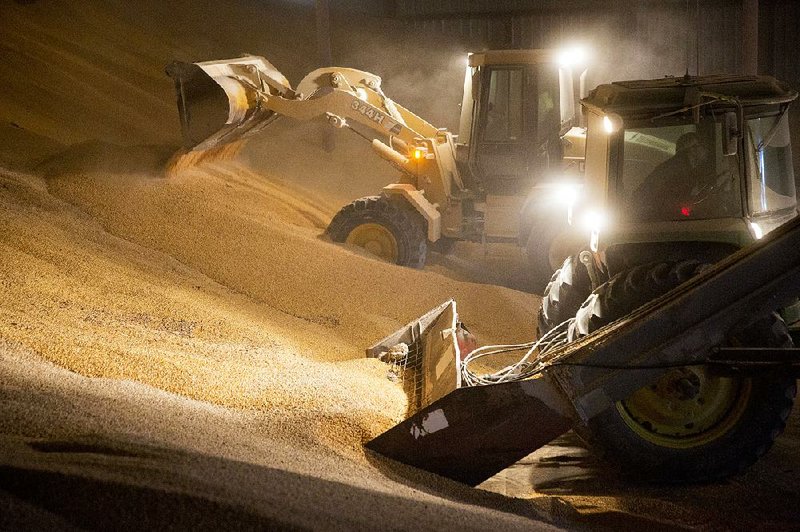There's an avalanche of grain coming as U.S. farmers gear up to harvest record corn and soybean crops. And one question looms large: where will it all go?
Growers are clearing bin space and elevators are prepping outdoor facilities to manage the surge of grain that will be harvested starting this month. But it may not be enough. U.S. supplies of corn, soybeans and wheat -- including newly harvested crops along with leftover inventories from last season -- will outstrip all crop storage capacity for the first time in records through 1988, government data and analyst estimates show.
A third-straight national bumper harvest has created the storage crunch. Adding to the squeeze, a prolonged slump in agriculture prices made growers less willing to sell reserves from last season. Farmers still own 10 percent of last year's corn production, estimates Kent Jessen, director of grain merchandising at Heartland Co-Op in West Des Moines, Iowa. While gains in export demand have helped to clear some space, it's still going to be a tight fit and all the excess supply means the rout in crop futures could continue.
"It's definitely going to be a challenge to find enough storage this year with a record corn crop coming in Kansas," said David Pfizenmaier, Clay Center, Kansas-based grain merchandiser for AgMark LLC, which markets grain for five cooperatives with storage capacity of about 60 million bushels. "There will be plenty of supply and cash bids will stay weak longer after harvest peaks."
Projected production of corn, soybeans and wheat combined with last year's inventories mean farmers and elevators will handle 24.3 billion bushels of grain in the 2016-17 season, outstripping the 24.2 billion bushels of on- and off-farm storage available, according to U.S. Department of Agriculture data and average analyst estimates for this year's production. The agency will update its harvest outlook Mondayat noon in Washington.
Farmers had been waiting to sell, hoping to see a recovery from a three-year slump in grain prices before the end of the marketing year last month. They've had no such luck. Corn futures traded in Chicago last week reached the lowest since September 2009.
"The clock has rolled over to a point that the farmer's run out of time, so he's emptying bins and bringing it to town as fast as he can," said Jarod Creed, the Omaha-based senior director of customer risk management at Gavilon Group LLC. "The problem with that is the crop size last year was large enough that the western Corn Belt states just are not going to be able to dig themselves out of a hole."
In a bid to beat the crunch, grain buyers have expanded storage capacity ahead of the harvest. Effingham Equity Cooperative in central Illinois purchased another elevator to bring its storage capacity close to 7 million bushels. Still, the group estimates it will have to dump 10 million bushels of corn on the ground -- a practice that's not out of the ordinary with bumper crops.
"You have to be ready with logistics and space or you will be plugged at harvest," said Effingham general manager Mark Tarter.
Some areas -- particularly in western grain regions -- are already feeling the squeeze. In central Kansas, AgMark has moved wheat to ground bunkers for the first time in five years. Last month, the grain merchandiser stopped allowing producers to rent wheat storage at all its locations for the first time in its 17-year history.
Strong demand from foreign buyers can help absorb excess domestic supply and clear storage space. Analysts surveyed by Bloomberg News forecast that world inventories of corn, soybeans and wheat before the 2017 Northern Hemisphere harvests will probably be smaller than the USDA projected last month. U.S. supplies of corn and soybeans are making up for global crop losses after flooding in Argentina and drought in Brazil. Shipments of grain by rail and barge over the past 14 weeks have been running at the highest pace since 1999.
Information for this article was contributed by Shruti Date Singh of Bloomberg News.
Business on 09/10/2016
